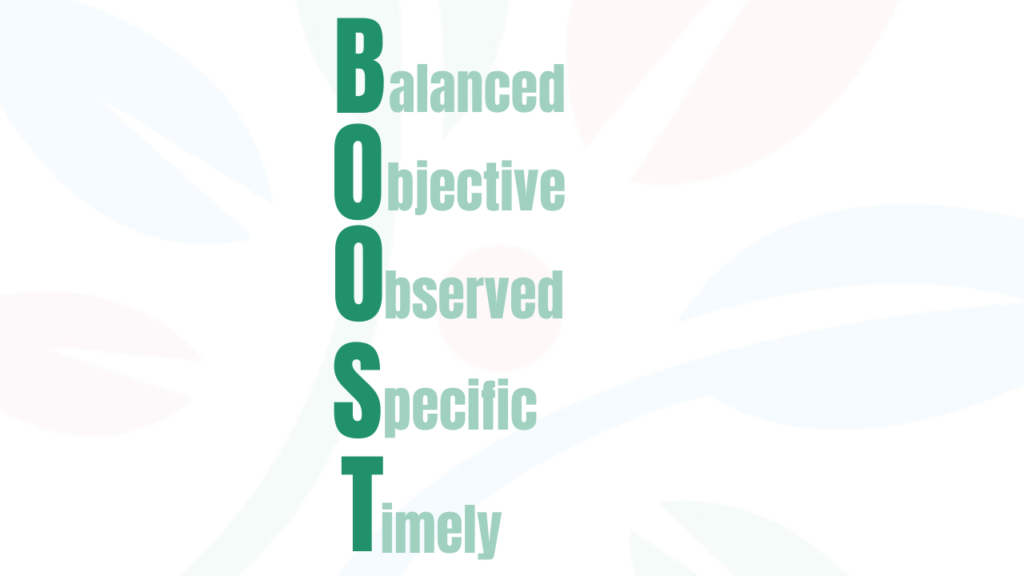Raise your hand if you love giving difficult, constructive feedback.
If I could look around the room at everyone reading this, I suspect I wouldn’t see a single hand in the air.
It’s not fun to tell people they need to improve. Yet, giving clear and honest feedback is one of the kindest and most valuable things a leader can do.
Constructive feedback helps people understand what they’re doing right and where to improve. It provides learning and growth opportunities to empower people to succeed in their jobs. And, believe it or not, it can also strengthen your relationship with the other person.
If you struggle with having difficult feedback conversations, try these strategies.
Your Mindset
Your mindset will affect your ability to provide effective feedback. If you shift your mindset from fear or frustration to confidence, you will have a more effective conversation. How do you make that shift? Try these orientations:
Helpful Orientation: Focus on being helpful rather than judging or punishing. You are helping the other person by providing clear expectations and direction.
Big Picture Orientation: Focus on the big picture. By providing this feedback, you empower the other person to be more successful in their career and help the company in the long run.
Win-Win Orientation: Focus on win-win outcomes. Your goal is to create the best overall outcome for all stakeholders – the individual, the company, and yourself. The feedback conversation might lead to improved performance and a better working relationship, or it might lead to the other person leaving the organization to pursue a career that is a better fit for them. In both scenarios, it’s a win for all the stakeholders.
B.O.O.S.T. Your Conversation
Follow the B.O.O.S.T. model to prepare your notes and talking points for the conversation.

B = Balanced: Strike a balance between focusing on strengths and improvement areas. For example:
“You have done a great job this week getting all the marketing emails out to our customers, which should drive a good amount of new business. I did spot that the most recent message you sent had a spelling mistake in it. That can make us look unprofessional. What could you do next time to ensure that all the emails sent are 100% correct?”
O = Objective: Treat feedback as information, not a value judgment. Step back and think about what a neutral observer might say. Relate feedback to goals, organizational standards, and facts. For example:
“In our company values, we talk about the need to be customer-centric. This includes making sure that our customers receive the best possible service. In your most recent quality check, you scored 75%. This is below the target of 80%.”
O = Observed: Feedback should describe the person’s behavior, not your story or interpretation of their intentions. Speak for yourself and use “I” statements. Try to avoid generalizations. For example:
“I was disappointed when I saw you laughing at the new Technician struggling to change the filter because you have been with the company for five years, and you are an expert in that area, and he has just started.”
S = Specific: Keep feedback factual and unambiguous. Give examples to support the feedback and focus on one or two things at a time. For example:
“I saw you doing the self-inspection, which was thorough, but one is not enough to achieve the expected result. Doing two additional self-inspections per shift will help you perform better.”
T = Timely: Give feedback at the right time and an appropriate opportunity. For maximum impact, give feedback as soon as possible after the event. For example,
“The senior leadership team responded positively to your presentation this morning. I was surprised they stumped you when they asked for more information about the data. How might you be better prepared to anticipate their questions next time?”
Empty the Glass
Prepare the other person to receive feedback by helping them to “empty the glass.”
Imagine the other person as a full glass of water. Their mind is full of the challenges and stresses of their day. If you try to pour more water into the glass, it will overflow. Before the person can receive feedback, they need to drink some water to make room for it.
Empty the glass by asking questions and allowing them to share what’s on their mind first. Then, you can shift the conversation to the feedback discussion.
Proceed with Compassion
Share your desire to help the person have a successful, fulfilling career. When people realize your willingness to help versus judge or punish, it makes it easier for them to receive feedback and engage in the conversation.
I hope these tools help you with your difficult feedback conversations. Feel free to schedule a complimentary coaching session if you need additional help.
Schedule Complimentary Coaching Session
Wishing you the best!








0 Comments